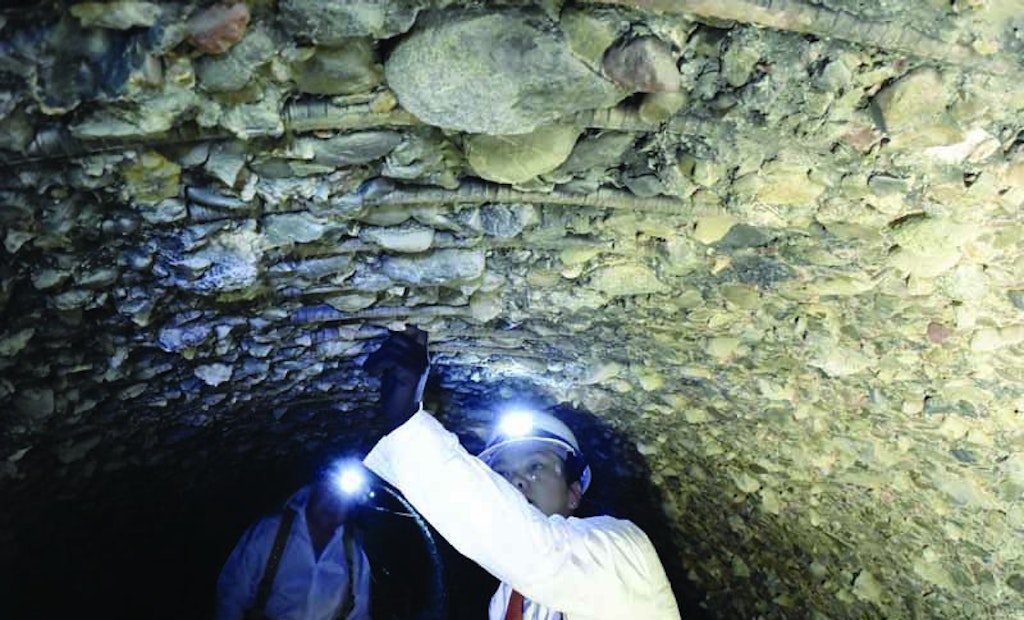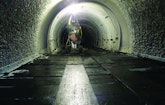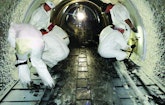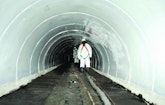
Interested in Inspection?
Get Inspection articles, news and videos right in your inbox! Sign up now.
Inspection + Get AlertsLining a mile of large-diameter sewer pipe is no small task. Doing it in a residential area with strict time constrictions and no bypass is even tougher.
When the East Bay Municipal Utility District in Oakland, California, was ready to rehabilitate a deteriorating section of its collections system in 2012, it turned to J.R. Pipeline. The company had already used the Linabond system in 2000 to reline approximately 2,300 feet of pipe for the utility.
But from tedious preparations to get the pipe ready for lining, to tight windows for completing the work and extensive measures to avoid disturbing local residents, the job proved to be challenging for J.R. Pipeline, says Elsabeth Girma, project manager.
“There were a lot of lessons learned along the way,” she says.
The project
EBMUD serves about 650,000 people from nine different communities in an 88-square-mile area on the east shore of San Francisco Bay. An integral part of its collections system is the 9,000-foot-long Wood Street Interceptor, a 105-inch cast-in-place concrete pipe dating back to the late 1940s. Beginning in the mid-1990s, the utility started gradually rehabbing the pipe after identifying areas of extensive corrosion.
The 2012 contract with J.R. Pipeline called for relining more than 5,000 feet of the horseshoe-shaped pipe, as well as spot repairs along another 2,000-foot section. J.R. Pipeline used the Linabond system, a structural polymer spray-applied onto concrete pipe followed by a PVC liner impermeable to corrosives.
The overnight work schedule was the first challenge on the three-year project, Girma says. J.R. Pipeline crews would mobilize around midnight and be ready to enter the pipe by about 2 a.m. The night’s work had to be wrapped up around 6 a.m.
“It’s part of the main interceptor and there was no redundant pipe,” she says. “The pipe could not be taken out of service, so all the work had to be done at night when the flow was lower.”
Work was done from April to October, the area’s dry season. Girma says EBMUD utilized a storage facility, typically only needed during wet-weather conditions, to keep the flow as low as possible throughout the night so crews could work in the pipe. A wood platform was constructed along the repair area about 2 feet above the bottom of the pipe before starting rehab preparations.
“At night the flow was already lower than during the daytime, and the utility would crank up its pump to direct more flow to the treatment plant and storage facility,” Girma says. “About 4 or 5 feet of flow in the pipe would be reduced to a height below the platform.
“On top of that, we had a blower to clean the air in the pipe. So when we went into the pipe, the air was fresh, the sewage was below the platform and workers could do their work.”
In the neighborhood
The overnight work schedule was maintained until this past year, when J.R. Pipeline arrived at a portion of the interceptor running through a residential area and had to account for how the work might disturb the neighborhood. While pre-lining preparations could still be performed entirely underground by accessing the pipe via a manhole in a non-residential area, that strategy was not an option once it was time to actually start the lining process.
“For cleaning the pipe beforehand, we could just go through a manhole where there weren’t residences and walk down 2,000 feet into the residential area. People didn’t even know we were there,” Girma says. “But for the rehab process itself, the lining rig has to be very close to the area being repaired.”
For lining the sections of pipe in the residential area, J.R. Pipeline got permission to extend its daily work schedule to 10 a.m. Underground pipe preparations began at 2 a.m. so that the crew would be ready at 6 a.m. when it was allowed to mobilize above ground in the neighborhood for lining.
“EBMUD did all sorts of hydraulic monitoring to figure out how much longer they could hold the flow for us and determined that they could go until 10 a.m. before we had to be completely out of the pipe,” Girma says. “That was a big challenge because by the time we started doing the rehab work it would be about 7 a.m. and we had to start pulling equipment out of the pipe around 9:30 a.m. So it was going very slowly. We were able to do about 75 feet per day. Sometimes we could do 100 feet if we were lucky, but it was very tight.”
Working in the neighborhood also required additional measures to appease residents. “No Parking” signs had to be placed along the next day’s work route the night before.
“The worst thing that happened was we had to tow some cars. We did it several times throughout the process,” Girma says. “We just tried our best to take a proactive approach and provide notice to the residents and let them know this was a crucial project for the neighborhood.”
EBMUD also rented a space from a nearby church to give residents a parking alternative during the times they had to stay off the street. Security guards monitored the area.
Pre-lining challenges
Scheduling logistics weren’t the only challenge on the job, Girma says. After taking care of spot repairs on previously installed liner in 2012, J.R. Pipeline went into 2013 ready to begin applying the Linabond system to the new sections of corroded pipe. But workers found pipe that needed extensive prep work for lining to be effective.
The first step was bringing in an experienced hydroblasting contractor. Mac & Mac Hydrodemolition of Surrey, British Columbia, scoured the pipe’s interior with 20,000 psi at 80 gpm to remove the corrosive buildup without damaging the good portions of concrete. That left large river rocks protruding from the pipe, creating a bumpy surface not ideal for lining.
“This pipe was cast in place, and in the 1940s when they built the pipe, they used river rocks,” Girma says. “The mortar was decayed so it fell off after hydroblasting, but most of the rocks didn’t come out. The surface was very rough, which required additional preparation work before beginning the lining system installation.”
J.R. Pipeline also had to go through and put in new rebar where it had corroded, and clean exposed rebar and coat it with a corrosion inhibitor. Then mortar could be applied.
“This had to be done before lining could even begin,” Girma says. “We’d be doing all this through July and finally begin lining in August.”
Once it was time to actually do the lining, the process went well even though progress was slow due to the tight work schedule.
Last October, J.R. Pipeline completed the final 1,800 feet of lining outlined in the contract. The rehab work is far from over for EBMUD, as the utility continues to inspect its system and contract work out as needed. But for the foreseeable future, the Wood Street Interceptor shouldn’t be a problem.









